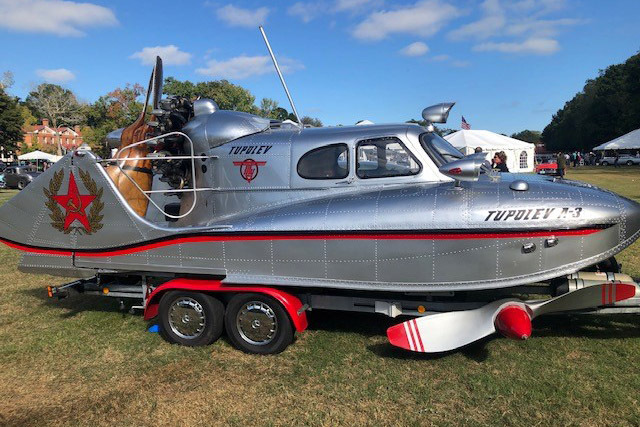
This Vehicle Is Whatever You Want It To Be
In Russia versatility is everything. Money is really tight, so the more you can get for your buying buck the better for you. The Tupolev A-3 Aerosledge is just such a product. It’s anything you want it to be in a vehicle.
Let’s say your commute includes swamps, lakes, highways, and byways. The Aerosledge can handle all of that and more. It’s an all-terrain, all-purpose monster of a vehicle. Built for the USSR military with very specific parameters, it was the brainchild of aeronautical engineer Alexei Tupolev.
Commissioned by Mother Russia to snap up Russian cosmonauts after a space mission

Conceived in 1961, Mother Russia needed an amphibious rescue craft to quickly recover Russian cosmonauts plopped into the bleak Siberian outback of desolation after a space mission. It had to do that plus fit inside an MK6 helicopter.
These missions would more than likely take place north of the Arctic Circle in nasty surroundings according to Hagerty. It had to be able to cross lakes, swampy tundra, operate in below-freezing temperatures, and more. Basically, it had to handle one of the harshest environments on earth.
This wasn’t Tupolev’s first rodeo developing land, sea, and air vehicles for the Russian government. He mothered the TU-144 jetliner and TU-95 strategic bomber among other projects. With that kind of cred, he also had anything he needed at his disposal courtesy of the Russian government.
Tupolev took an airplane and adapted a boat hull to it

What Tupolev did was take an A-3 Aerosledge aircraft and he adapted a metal hull made like an outboard boat. He used 2mm-thick duralumin-made from copper, magnesium, and manganese. The hull was double-plated. It had a coating of low-friction polyethylene so it could effortlessly slide over water or snow.
Measuring 20-feet long and weighing 3150-lbs., it could carry four men at over 75 mph on snow and 40 mph on water. In both cases, it hovered over the surfaces it traversed. Three bulkheads divided the fuselage creating watertight compartments. If one of them was punctured the Aerosledge could remain afloat.
Powered by a 10.2-liter Vedeneyev M14B air-cooled nine-cylinder radial engine it produced 365 hp. Attached to the monster engine were two interconnected propellers measuring six-feet. These propellers worked in tandem.
The radial engine is started by an air-pressure system able to function in sub-zero weather

There was no battery. Instead, it used a 500-psi air pressure system to start the radial engine in sub-zero temperatures.
When this one was manufactured in 1971 it was purchased by a Russian General. It eventually made its way to the US where it was auctioned off for $220,000 in 2015. It is up for auction once again at the Barrett-Jackson auction in Arizona this week.
The Aerosledge will be auctioned with all of its original paperwork, in addition to the tool kit and owner’s manual.
The current owner says that there are only three left in existence. What do you think it’s worth?



